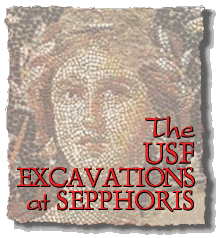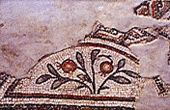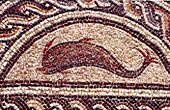
Sepphoris was first excavated for one season in 1931 by the University of Michigan. It has been under excavation since 1983 by the University of South Florida Excavations at Sepphoris and since 1985 by the Joint Expedition to Sepphoris. That two major expeditions would work on the site is an index to its importance in the Roman and Byzantine history of Palestine, early Christian origins, and Jewish history.
From ancient literary notices we know that Sepphoris had a theater, ten synagogues, several churches, a Council Chamber, an Archive, two market places, temples, a city wall, a mint (Sepphoris minted its own coins), an extensive aqueduct system, and a cemetery. In USF excavations since 1983, they have excavated a Jewish villa first excavated by the University of Michigan in 1931, a bathing establishment, and an enormous market building or basilica with stunning mosaics. They have recovered thousands of sherds, hundreds of coins, many fragments of glass, and other traces of the material culture of the city.
Since 1987, USF has been excavating a grand building – a market building or basilica – on the east side of the site. Built in the first century C.E./A.D. and going out of use 350 years later, the building occupies a single city block about 40 x 60 m. in extent. The main entrance into the building is from the Cardo to the southeast. Unfortunately, a bath built in the Byzantine Period on the southeast has obscured some of the history and use of the building at its east end. The building was founded early in the first century of the Common Era, perhaps at the turn of the century. The whole structure went out of use and was entirely destroyed about the middle of the fourth century C.E. This destruction is either to be laid to the Revolt of Gallus in 351 or to the earthquake of 363 or to both events. Interestingly enough, the foundation of the south wall, which borders the sidewalk on the south side, is actually a re-founding on a pre-existing wall. In this case the lowest course of foundation stones were custom-cut, as it were, to receive new stones with drafted margins, "Herodian" stones. This same type of foundation with stones dressed in the Herodian style is visible at the east end of the building in the main facade, which borders on the sidewalk of the Cardo.Stones dressed in this fashion early in the first century may suggest that the original building of this structure was at the behest of Herod Antipas, son of Herod the Great, who inherited Galilee and Perea from his father at this father's death. The general plan of the building is more like that of a basilica than any other structure in antiquity. Columns on the interior of the building held up a set of stone beams from column to column (architraves) upon which stood a clerestory or roofed, lofty hall down the central nave. These columns rested on Attic bases without pedestals and had Ionic capitals. Between the rows of columns within the central nave of the building were elaborate mosaic floors, especially near the end of the history of the building. Everywhere else one saw bright, white mosaic floors, which would help multiply the light available. Interior lighting came from windows high above that pierced the walls directly above the upper, smaller columns, which stood on the architraves above the columns on the floor. The USF Excavations found window glass from these windows everywhere, but chiefly at the western end of the building. The central space, surrounded by columns and paved with mosaics, was in turn enclosed by corridors or aisles paved with white mosaics. The aisles were provided with double black bands that seemed to lead foot traffic. The double bands led down the side aisles and across an aisle near the west end of the building which led from one side to the other. The two side aisles, on the north and on the south, are not identical in width. The southern aisle is about 2.4 m. broad, but the northern aisle stretched to 5.7 m. The cross aisle, across the width of the building, was about 3.5 m. wide. A row of small rooms, shops, or offices line the south side of the building and its north side. Of those which have been excavated so far, most reveal elaborate mosaic floors in geometric patterns, but also, in some rooms we found detailed representations of birds. Oddly, these rooms do not open directly on to the street, as is the rule with shops attached to a basilica. They are only accessible from within the building. It is also interesting to observe that a long corridor separates the rooms on the south from the south street. This corridor may be a service corridor for these rooms, shops, or offices. At least one of these rooms contains a stepped, plastered pool rather than a geometric mosaic floor. The west end of the building contains a special area set off on the south and north by the small rooms or shops, on the east by the columns and white mosaic of the cross aisle, and on the west by the west wall of the building. This west wall was actually founded deeply into the slope of the hill, as the natural slope is down to the southeast. There is no apse on this wall, which is a surprise, given the building's basilical plan. This special area occupies the 24 m. across the east end of the building, but it is not a tribunal, as one might expect to find, as it is not raised above eye level. The actual space within the columns and the west wall is nearly square: about 11 m. north-south and 11.75 m. east-west. In the center of this space lay an extraordinary mosaic with birds and fishes. In the original use of the space there were two pools to the north and south of the central mosaic. Each pool was heavily covered with hydraulic plaster on the inside, which is part of the evidence that these were filled with water. The pool on the south was also equipped with two elaborate drains near the top of the stylobate that surrounded it to allow excess water to decant to the south into a drain beneath the floor. Each pool was surrounded by six columns with Ionic capitals and Attic bases in two rows of three each. The mouth of a cistern stood just west of the central mosaic, but the pipe that brought water to the cistern is no longer extant. The combination of pools, mosaic, frescoed walls, and columnation centered on the long axis of the building suggests that this may be a special reception hall or a suite for entertaining, perhaps even an oecus. About the end of the third century or at the beginning of the fourth century the building underwent renovations. During these renovations the northern pool was filled in, and a white mosaic with a black trellis pattern was installed over this fill. At present there is no evidence to suggest the reason for this change, but one might guess that there was a new administration and perhaps therefore a new aesthetic. Between the columns of the central area east of the splendid birds and fishes mosaic is another mosaic, this one principally geometric in its patterns. One panel of this mosaic, oriented on the long axis of the building, shows a city-scape and the Greek inscription EYTYXWC or "Good Luck." What was the building used for? This is still a vexing question after so many years of excavation. The possible reception hall at the west end of the building has already been mentioned. So many coins were found on the floor to the east of this area that it suggests economic activity was going on, and that "pennies" were ignored when they were dropped. Such a large number of short nails were found to suggest that frames for stalls or other kinds of furniture stood on the floor here and there; so many storage jar fragments were found One more clue about the use of the building is suggested by the representation in the western mosaic of the bird with feet tied. If it was economic activity in a sumptuous surrounding, then we may have found a market for luxury goods. The rabbis knew of an upper market and a lower market at Sepphoris (y Ta'an. 3.4), so there is a great probability that this is the lower market. Because of the expensive nature of the contents, the rooms were well picked over after the abandonment and destruction of the building in the fourth century C.E. On the other hand, the presence of an oecus or at least of a reception hall suggests that our best deductions will remain tentative. It is also possible that the building is a public basilica in which one may rent space for receptions, economic activity, offices, and perhaps other reasons. The most important historical point is that such a splendid building existed at Sepphoris on the main Cardo of the city and served an elegant clientele. Excerpted from The Eastern Basilica Building at Sepphoris by Dr. James F. Strange © 1997 Dr. James F. Strange
| |||
Reading: All materials contained in the CenturyOne Foundation Web Site are protected by copyright and trademark laws and may not be used for any purpose whatsoever other than private, non-commercial viewing purposes. Derivative works and other unauthorized copying or use of stills, video footage, text or graphics is expressly prohibited. |


